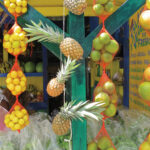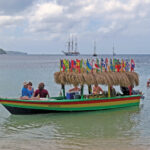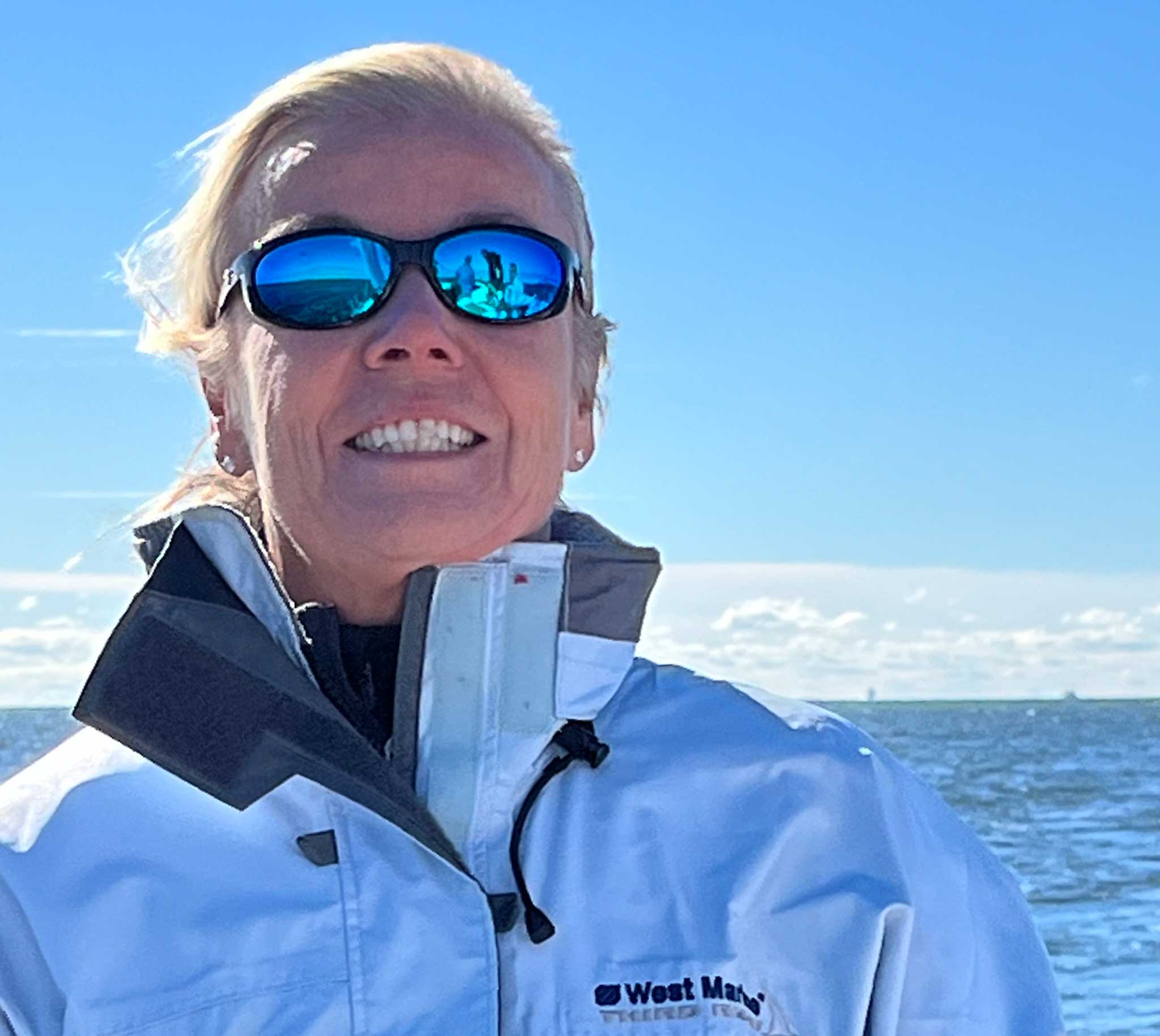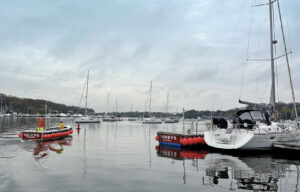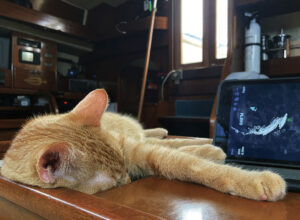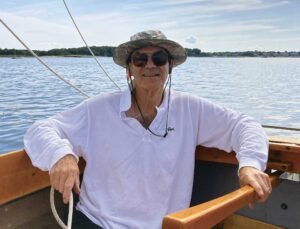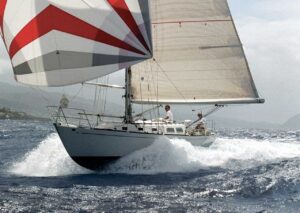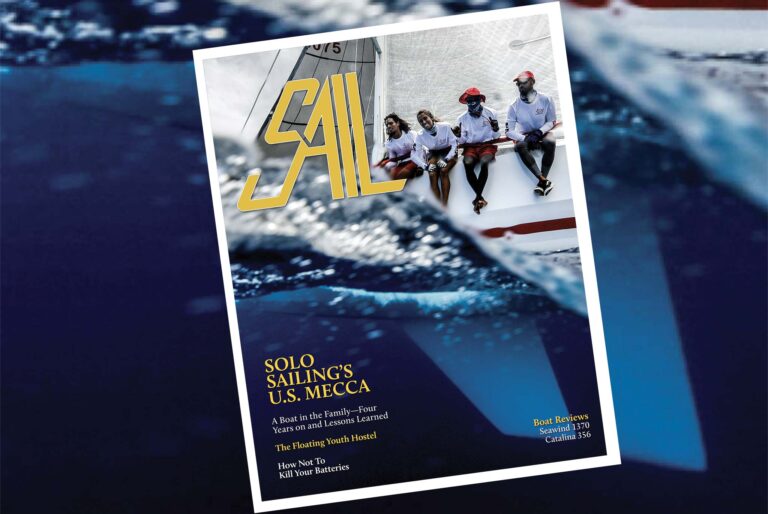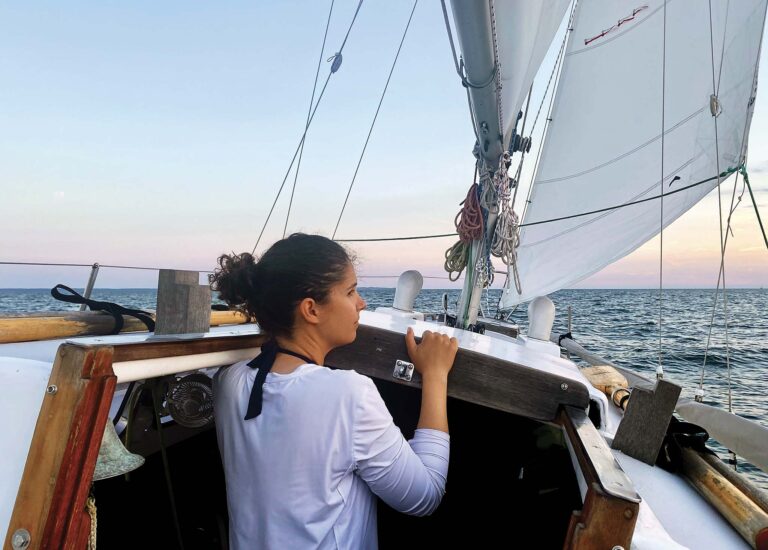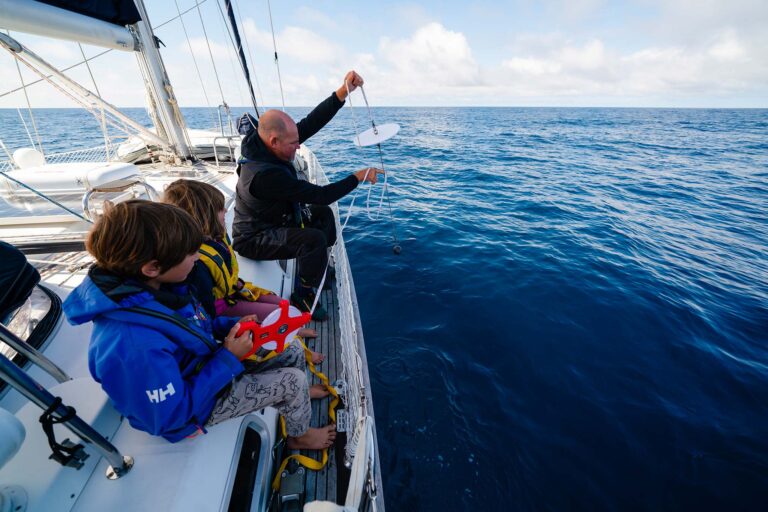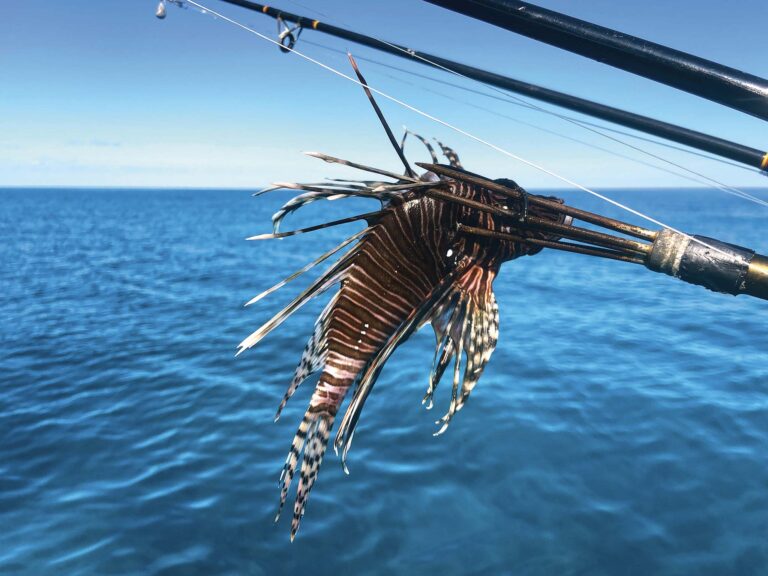
Our Dream Yacht Charter delivery started as a “wouldn’t it be fun if” idea. Those are usually misguided, if not downright stupid. But a Bali 4.3 named Jumelles (French for “twins,” appropriately) needed to leave Guadeloupe to do heavier charter work in Grenada, and as soon as I heard, I knew she was our ride.
A quick glance at the charts showed us that we’d weave down the southern-most Leeward Islands and then explore the Windwards over a meandering course that covered a few hundred miles. This long slice of the Caribbean is hardly ever seen at one stretch except by cruisers on a leisurely timeline. We were fast-moving charterers on a schedule that spanned the tail end of hurricane season. A timetable to move a boat in October—what could possibly go wrong?

The Itinerary, Weather and Crew
I’d done parts of this trek before, so I knew where to spend time. My crew, Joe and Frank, had sailed with me several times before, and each had requests. Joe desperately wanted to return to Bequia to relive his breakfast fantasy where fresh baguettes are rowed out around the anchorage every morning. Frank had not visited the Eastern Caribbean at all and wanted an adventure as well as more miles under his keel.
After a two-cart provisioning run and a festive dinner at Route du Rhum restaurant in Pointe-a-Pitre, we left early the next morning. The weather forecast looked sketchy. We expected 20-25 knots with 6 to 8ft seas. But what we got was 35-40 knots with 8 to 12ft seas—at least for the first few days. They don’t call them the Windwards for nothing.
Hurricane Maria had just rolled over Guadeloupe’s Les Sainte Islands, and we were warned off stopping there. So, we literally blew past as the wind piped up to 40 knots and at the end of the first day, tucked into the bay at Portsmouth on Dominica, an island that was at the top of my must-see list. Sadly, I’ll have to plan another visit to see the pristine inland reserves I had heard so much about because Maria devastated the island. Large ferries and small cruising boats lay on their sides, dotting the beach in both directions. Nothing but brown husks poked up along the hillsides. Wind and waves met us again the next day as we sailed, mostly on a beam reach, toward Martinique. Despite keeping an eye on our chartplotter on the flybridge, we found ourselves set significantly to the west and had to loop back to windward to make landfall. The last few hours were hard-won and slow going.
Coming into Anse a L’Ane after dark, we confirmed that our GPS was off as the plotter insisted we keep to the right—pointing us directly at the reef. I had loaded Navionics charts on my phone prior to departure, which allowed us to creep in, staying off the hard bits to the south. Lesson learned: henceforth, we needed to (over) compensate.
The cruising guide warned that the local fishermen wanted all anchoring to be done to the right of the pier, so we dropped anchor and as other boats came into the left of us, we were confident we had landed in the right place. But that wasn’t the case. Next morning, Joe and I noticed something snaking up with the chain. I stopped the windlass and investigated. We had dragged across (and then became impressively entangled in) a Dacron fishing line with lengths of filament ending in large hooks and fish heads. Over the next 45 minutes, I removed 14 hooks and handled countless chunks of fish parts as I cut the line free. Apparently, not all the fishing was done to the left.
Soon we rounded the corner and got blasted with 40 knots again, which continued all the way down to Rodney Bay on St. Lucia. Frank fed the fish his breakfast and complained that the (nonexistent) trip brochure never mentioned 12ft waves. Joe looked a little tired as he sat out an obscene downpour at the helm. Clearly, it was time to take a break from what had become a delivery rather than a vacation.

With that in mind, we pulled into the posh Rodney Bay Marina to fuel up and have dinner on solid ground. Making this a rest stop, we also rented a car, and with Frank at the right-hand side wheel continually and accidentally setting off the windshield wipers, we circumnavigated St. Lucia in a rented Peugeot. By the time we stopped for lunch, our sides were hurting from laughing over our inability to read a map or drive on the “wrong” side of the road. The crew’s mood had lightened considerably.
Our dining room overlooked the iconic Pitons, a postcard-perfect view accompanying our lunch of delicate French appetizers. Honeymooners strolled lazily by on no schedule at all.
We had a lovely rest until later that evening when Frank became embroiled with a local over the proper etiquette of a Kansas handshake (which seemed friendly and funny to all but the local). Maybe it was time to set sail on the last long hop down past St. Vincent to Bequia, the northernmost of the Grenadine chain.

Creative Problem-Solving
With our projected course-made-good running directly over St. Vincent, we successfully cleared the bottom of the island and headed directly into Admiralty Bay on Bequia with plenty of sunlight left to catch a mooring and enjoy happy hour. No more looping back. We had mastered the plotter, and it had only taken three days.
Bequia is an island I could sail to annually and never get enough of. Friendly people all around, good shopping in Port Elizabeth and endless choices of restaurants along Belmont Walkway are just a few of the reasons to visit and then re-visit the largest of the Grenadines. The islands have a “boat boy” culture where people in small boats help you catch a mooring, collect trash and summon the bread man for an early delivery of croissants, banana bread and baguettes. By 0600 the next morning, Joe had the butter and jam out on the saloon table, anxiously awaiting the bread man. Judging by the expression on his face on the first bite, that breakfast was his entire reason for the trip.
After a day of exploration and checking in at customs and immigration, we came back to a very smelly boat. We had taken a thrashing over the past few days, and now some fossilized chunk had worked its way loose in the starboard holding tank and clogged the outlet. I never allow toilet paper in the heads, but who knows what the previous charter group was up to and how long the offensive mass had steeped in the tank? After trying to dislodge it from both ends on our own, we enlisted the help of a local to dive the boat. After two hours of snaking the discharge outlet, he finally surfaced and excitedly shouted “Volcano!” It cost us four beers and $200 and was worth every penny.
Setting sail again, we rounded the south side of Bequia, with its ominous shipwreck on the rocks, and headed for Mustique, the island of celebrity homes and $30 cocktails. Basil had sold his infamous bar to the island company, and it was in the process of being rebuilt. So, having no place to celebrate our arrival, we took a taxi tour of the small island, learning where Mick Jagger’s house was and that Bryan Adams’ raucous birthday party had been held just the week prior. Clearly, my invitation had been lost in the mail.
After dinner aboard we watched the sunset, overlooking the nearly empty bay of $75 per night moorings. Visiting during the low season had its advantages. I had been monitoring the batteries, but (as I was told at the end of the trip) the gauge wasn’t really working, and so our batteries drained overnight. This was more embarrassing than alarming as I swore to the crew that it was my first time having a dead ship.

It was a national holiday in the Grenadines and not a soul in sight to help except the crew of an inter-island ferry. We, therefore, borrowed their jumper cables, forklift battery and even their engineer and got started. That cost us a bottle of rum and $50. On long stretches with significant distances between charter bases, you need to be self-sufficient.
That afternoon we motored into the Tobago Cays—truly paradise on Earth. This cluster of idyllic islands is tucked behind a horseshoe reef where every shade of aquamarine water invites you to relax and forget about civilization for a while. Parts of the Pirates of the Caribbean movies were filmed here and you can imagine Captain Jack Sparrow with a rum bottle rounding the corner of the beach. This was my third visit, so I knew the drill: anchor, snorkel with turtles off Baradel Island, buy T-shirts from the boat boys, relax on the flybridge with a glass of wine and then book a beach barbeque for the evening. The lobster on the open grill is divine, but bring bug spray or you’ll be the meal.
From there we threaded our way through the southern exit of the Cays and headed the five miles to Clifton on Union Island. This is the last of the Grenadines that belongs to St. Vincent so we caught a mooring, dinghied to shore and walked to the airport to check out.
Clifton is defined by color. Everywhere the eye falls, there are bright hues of orange, pink, blue and yellow. The shopping is excellent in the produce market and in the many boutiques like that of Annie-France du Lac, a petite French woman who’s quite skilled at separating you from cash as she walks you through her one-of-a-kind jewelry.
Sunset in Clifton means drinks at Happy Island, made entirely by an enterprising local who gathered cast-off conch shells and built a small island on the reef in the harbor. He then added a grill, a bar and, voila!, a tourist attraction was born to which you can only swim, dinghy or take a water taxi. The sunsets are spectacular, and the rum punch packs a punch. I vaguely remember the delicious conch chowder and a discussion among the crew of selling the captain for what, even my foggy brain thought, was way too little.
Our last stop before Grenada was Sandy Island, a spit of sand off Carriacou that surprisingly, has no bar on it. This is the place to bury your toes in sugary sand and watch seabirds dive for their lunch as you try to snap a shot of your lonely footprints before the waves erase them.
The Boat
Having sailed most production cats over the last few years, I was looking forward to spending time on a Bali. These are designed as workhorse charter boats that are comfortable and easy to sail, especially for larger groups that are usually made up of less salty individuals. Away went the forward trampoline, replaced with a solid deck completely covered by sunpads and a settee. A domestic-sized refrigerator was added inside. And that’s when the trouble started.
How could a Bali possibly take on big seas with a patio on the bow and house-sized appliances inside? Critics said the boat was too heavy forward and too light overall. I must admit, I myself had looked askance at that giant front yard.
Well, I’m eating my words now. Jumelles performed admirably even in snotty conditions. In the three early days of big wind and seas, we kept a reef in the main and genoa and rolled along at 9-10 knots even as we climbed 12-footers. Later, when the wind all but died, we unfurled the laundry and kept moving nicely. And that fridge with the special insert door where we stored chocolate cookies? Yeah, we got used to (hooked on) that in about a half a day.
Successfully Delivered
We sailed into St. Georges, Grenada on the last day with the usual mixed emotions after a delivery. It was good that Dream Yacht wouldn’t be sending out a posse after us, but it also meant the adventure was over.
The last of the mango and kiwi were eaten for breakfast and goodbyes were said as we all headed in different directions. Joe had gotten his baguette, Frank had seen a swath of islands he’d dreamt of and I had learned that chartering by delivering was a great way to do hundreds of miles of cruising on someone else’s boat—which is the best kind. That it was all done on a schedule and during hurricane season was just a serendipitous bonus, because anchorages are empty and restaurant reservations aren’t required in the low season. Sometimes, things just work out and nothing really goes all that wrong even if the initial idea may be ill-advised.
Zuzana Prochazka chartered with Dream Yacht Charters (dreamyachtcharter.com)
Photo Zuzana Prochazka
MHS Summer 2018
